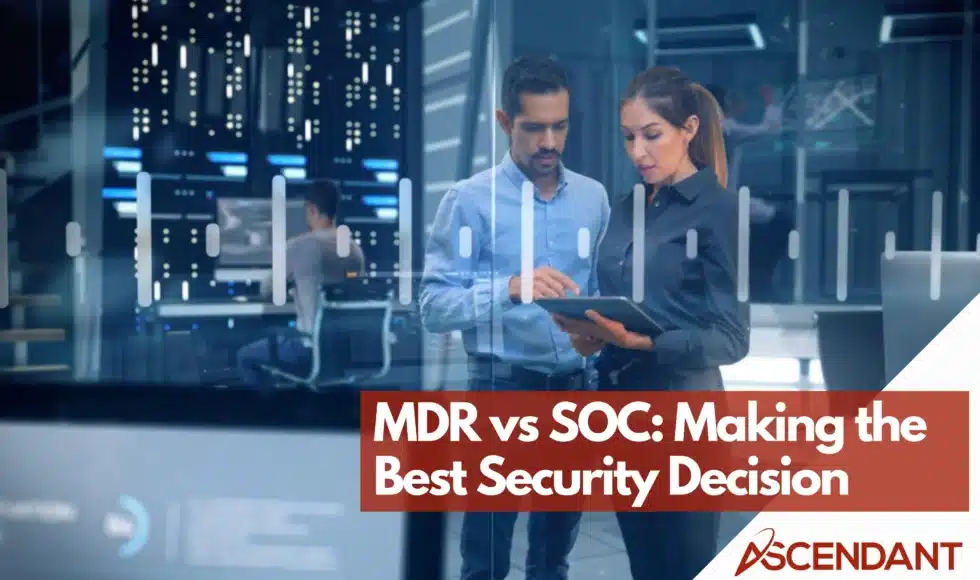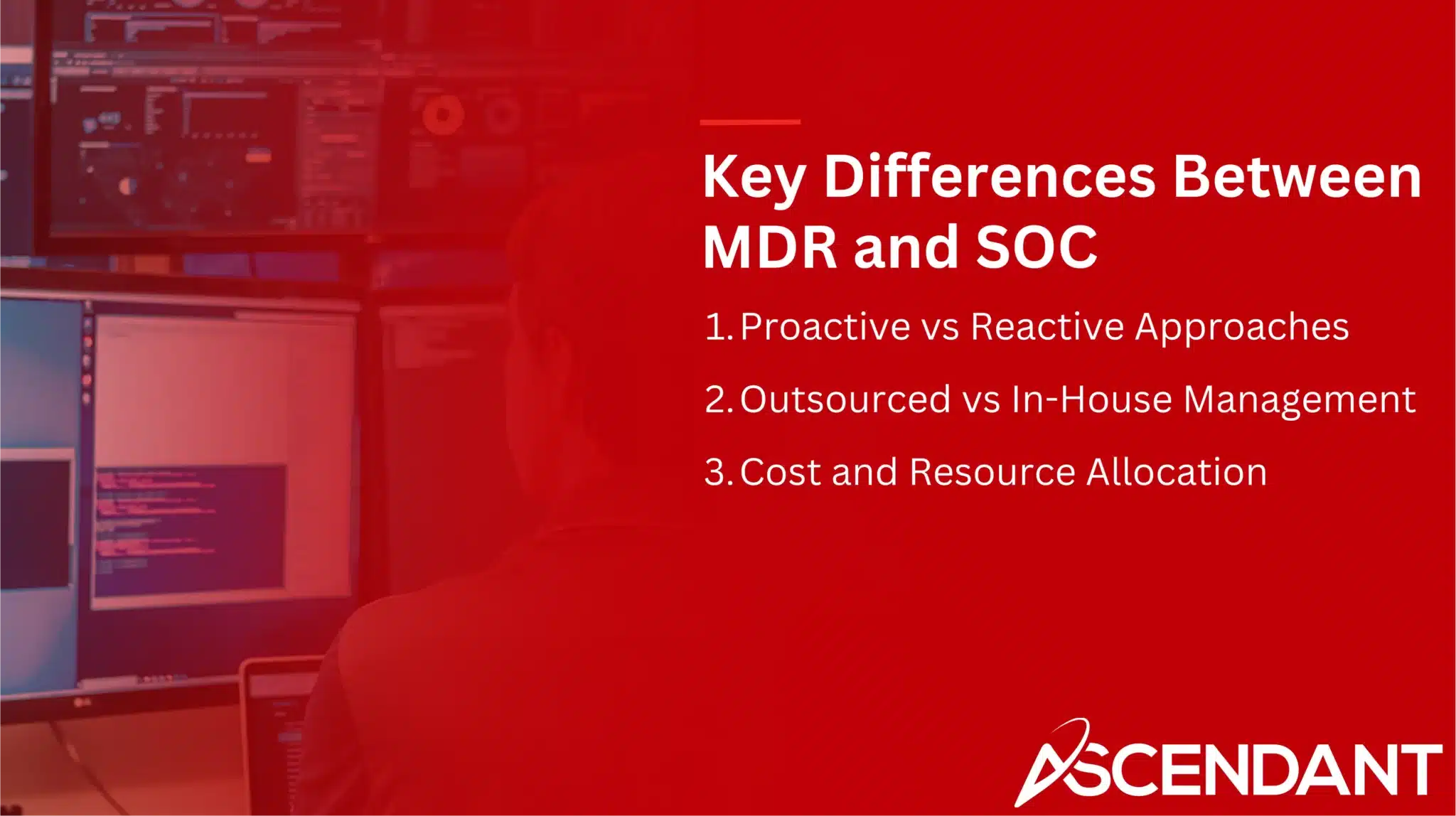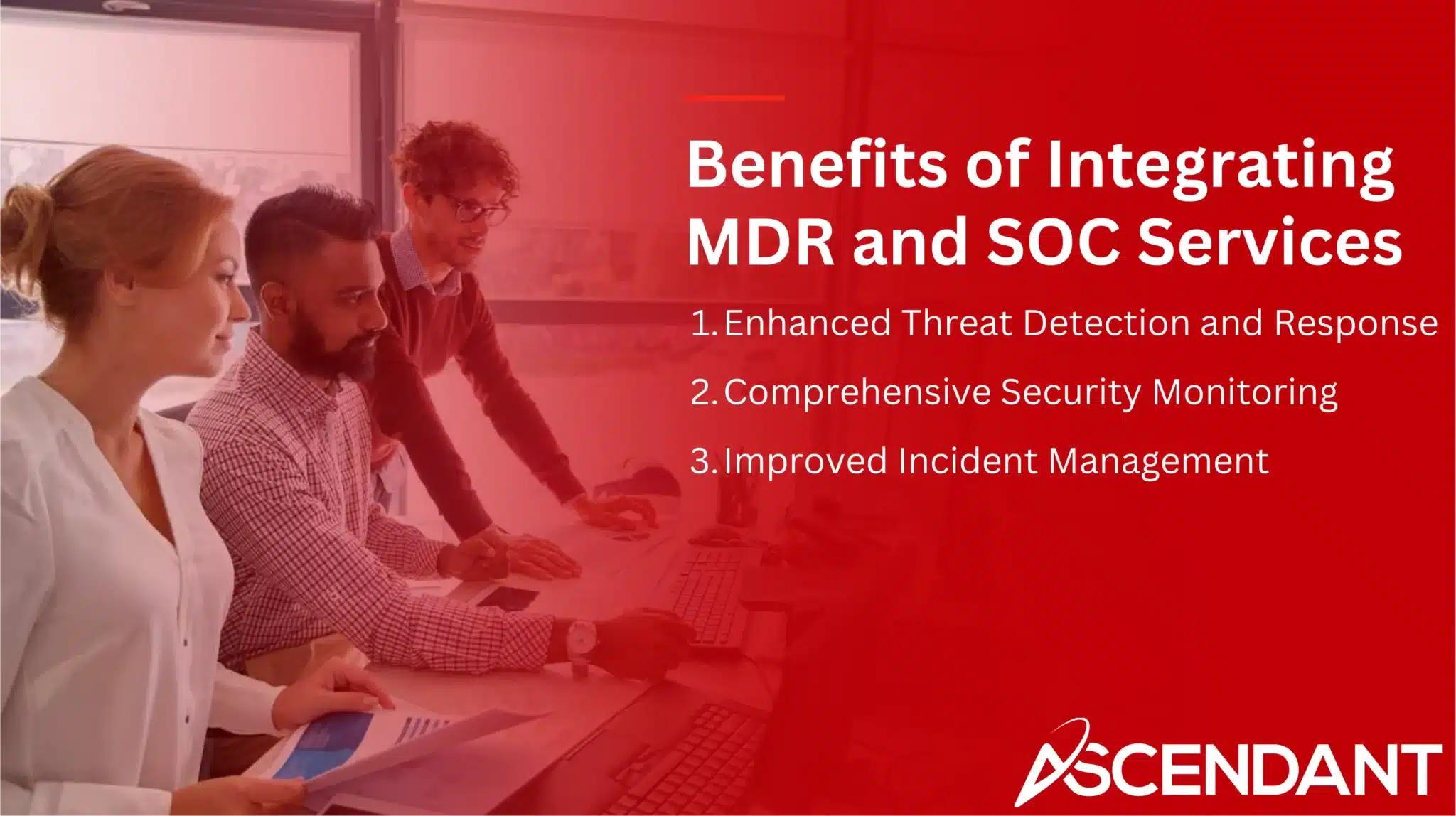MDR and SOC are two approaches to cybersecurity. This article breaks down their key differences in the context of mdr vs soc and helps you decide which one suits your organization’s needs.
In This Article:
- Understanding MDR and SOC
- Key Differences Between MDR and SOC
- Evaluating Your Cybersecurity Needs
- Benefits of Integrating MDR and SOC Services
- Implementation Strategies for MDR and SOC
- Advanced Technologies in MDR and SOC
- Choosing the Right Service Provider
Key Takeaways
- MDR services focus on proactive threat detection and rapid incident response, while SOC provides continuous monitoring and incident management.
- MDR is typically outsourced and cost-effective, making it suitable for organizations with budget constraints, whereas SOC requires an internal management structure and significant investment.
- Integrating MDR and SOC enhances threat detection and response capabilities, providing organizations with a comprehensive and robust cybersecurity strategy.
Understanding MDR and SOC
To distinguish between MDR and SOC services, it’s essential to comprehend their unique functions within the realm of cybersecurity. Both are crucial in protecting your online resources, albeit through distinct approaches.
MDR (Managed Detection and Response) emphasizes preemptive detection of threats and swift response actions by employing cutting-edge technology to outpace cyber threats. In contrast, a Security Operations Center (SOC) provides an overarching perspective on network security with its focus set on persistent surveillance and handling of security incidents.
What is Managed Detection and Response (MDR)?
Managed Detection and Response (MDR) is a third-party service aimed at enhancing threat detection, providing ongoing monitoring, and ensuring swift action in response to security incidents. The fundamental objective of MDR services is the expeditious identification and neutralization of threats, thereby reducing the duration required to handle security breaches. Utilizing state-of-the-art technologies such as artificial intelligence (AI) and machine learning enhances their ability for incident response. This technological application empowers MDR providers to effectively uncover complex threats while streamlining cybersecurity management tasks.
Through relentless network surveillance coupled with active measures for detecting potential dangers, MDR offerings swiftly pinpoint and counteract security compromises. Given the ever-evolving nature of cyber risks in today’s digital environment, maintaining a proactive approach complemented by expedient reactions is essential in curtailing harmful impacts.
By partnering with an MDR service provider, your organization can significantly bolster its defensive stance against virtual hazards—ensuring increased assurance amidst our digitally reliant society.
What is a Security Operations Center (SOC)?
A Security Operations Center (SOC) is a centralized hub for managing an organization’s cybersecurity operations. Security operations centers oversee cybersecurity activities, manage security incidents, and ensure regulatory compliance. It operates by actively monitoring network traffic, assessing security incidents, and ensuring compliance with security policies. SOC teams, usually composed of security experts such as analysts and staff, collaborate to maintain robust security monitoring and quick incident response.
The SOC utilizes a variety of tools, such as Security Information and Event Management (SIEM) systems, network security monitoring, and Endpoint Detection and Response (EDR) tools, to enhance protection against threats.
When an alert is triggered, SOC teams and the security team investigate to determine the nature and validity of the threat, prioritizing real threats to minimize response times for containment and remediation. This comprehensive approach ensures that all potential security incidents are addressed promptly and effectively, maintaining the integrity of the organization’s network security.
Key Differences Between MDR and SOC
MDR services and SOC services both serve to safeguard organizations against cybersecurity threats but utilize distinct methodologies to achieve this objective. MDR focuses on identifying and swiftly reacting to IT security risks by leveraging sophisticated technologies, while SOC provides extensive protection through persistent surveillance and management of incidents.
Acknowledging the principal distinctions between these methods is critical for organizations when planning their approaches to cyber defense.
Proactive vs Reactive Approaches
MDR services are structured to preventively combat security threats by utilizing forward-looking threat detection methods and searching for vulnerabilities, often incorporating AI technology. This anticipatory stance allows MDR to identify and address new or complex threats quickly, thus reducing their potential disruption to business operations. The key objectives of MDR services include the early identification of advanced threats, ongoing vigilant monitoring, and swift reaction times.
On the other hand, SOC activities tend towards a more reactive strategy that deals with threats post-occurrence. SOCs concentrate on safeguarding informational assets through instantaneous analysis coupled with prompt action following security incidents.
While SOC teams do partake in preventative surveillance measures, their primary function revolves around responding to reported incidents, examining alerts rigorously, and administering security events as they unfold. The variance in strategies underscores how MDR and SOC services complement each other—the former is oriented toward averting risks while the latter adeptly handles them once they have manifested.
Outsourced vs In-House Management
The organizational approach to managing MDR and SOC services stands as a principal distinction between the two. Outsourcing MDR services often allows for robust security measures without demanding the considerable resource and staffing commitment needed to set up an in-house SOC, making it a compelling choice for entities looking to bolster their security posture economically.
In contrast, having an internal team manage a SOC affords benefits such as ensuring adherence to regulatory standards and granting direct physical access to systems that need monitoring or intervention.
Cost and Resource Allocation
Establishing an in-house Security Operations Center (SOC) can be a costly endeavor, necessitating substantial investment in both technology and staff. On the other hand, Managed Detection and Response (MDR) services usually adopt a subscription-based model. This approach often entails either monthly or yearly fees, which provides organizations with a stable expense framework that assists them in better budgeting for their cybersecurity needs.
MDR services are designed to augment current security protocols rather than serve as basic protective measures like SOC typically does. Consequently, MDR represents an economical option for companies looking to enhance their defensive capabilities without the need for extensive training or additional personnel recruitment.
Evaluating Your Cybersecurity Needs
Determining whether to opt for MDR or SOC services involves a comprehensive analysis of your company’s cybersecurity requirements. It is essential to grasp the distinctions in terms of operational reach, implementation, oversight, and personalization possibilities when making an educated choice.
It is important for companies to pinpoint their particular cybersecurity needs and objectives, gauge the robustness of their existing security posture, and take into account both financial limitations and the potential expansion capabilities of the services under consideration.
Business Size and Complexity
Your company’s scale and complexity are critical in choosing the right cybersecurity approach. MDR services tend to be a better fit for small and medium-sized businesses (SMBs) because they can easily adjust to business size while demanding fewer resources.
Conversely, bigger enterprises with intricate network structures might gain more from the extensive surveillance and incident management offered by establishing an internal SOC.
Existing Security Capabilities
Before deciding whether to opt for MDR or SOC services, it is critical to evaluate your current security framework and pinpoint areas where threat detection and response could be improved. For organizations that already have a solid security infrastructure in place, MDR offers an opportunity to augment their existing defenses without the necessity of extensive modifications within their internal systems. It’s also crucial for employees to receive ongoing training and for alert mechanisms to undergo regular reviews so as to effectively respond against emerging threats.
Prioritizing the integration of MDR services with present security apparatuses and protocols is key in establishing a comprehensive defense strategy. Such harmonization fosters superior threat intelligence gathering capabilities and more effective reaction plans, bolstering abilities to detect looming security threats while strengthening the overall defensive stance.
Consistently re-evaluating approaches toward cybersecurity allows organizations greater resilience by adapting proactively against new types of cyber dangers they may face over time, thereby fortifying their overarching digital protective measures.
Budget Constraints
When choosing between MDR and SOC services, financial considerations are pivotal. The initial expenses associated with MDR services tend to be more modest than the significant capital required to establish an in-house SOC. Opting for outsourced MDR can diminish the operational expenditures related to recruiting and educating personnel, thus presenting a financially prudent option for numerous firms.
Managed Service Providers (MSPs) furnish adaptable services that align with both fiscal limitations and security requirements, delivering a cybersecurity strategy that is both flexible in nature and economical.
Benefits of Integrating MDR and SOC Services
Incorporating both MDR and SOC services creates a solid and all-encompassing approach to cybersecurity. By merging the active threat hunting capabilities of MDR with the persistent surveillance provided by SOC, an improved defense mechanism against progressively changing cyber threats is established.
This unified strategy tackles various cyber threats effectively, guaranteeing that security incidents are met with swift action thanks to this integration.
Enhanced Threat Detection and Response
Merging Managed Detection and Response (MDR) with a Security Operations Center (SOC) significantly boosts an organization’s capacity for real-time threat detection and response. The SOC contributes its strength in threat intelligence and perpetual vigilance, which when paired with the MDR’s emphasis on forward-looking threat identification and swift reaction, fortifies defenses against cyber threats. In this symbiosis, SIEM tools are vital as they gather and scrutinize log data to provide immediate awareness of prospective dangers.
Employing cutting-edge technologies alongside ongoing surveillance helps organizations more effectively pinpoint and counteract evolving threats. This robust strategy in identifying threats proactively ensures that potential security incidents are dealt with promptly. By quickly addressing these possible concerns, the risk of experiencing security breaches is reduced while simultaneously bolstering the overall stance on security.
Comprehensive Security Monitoring
Integrating the ongoing vigilance of a Security Operations Center (SOC) with the proactive capabilities for threat hunting inherent in Managed Detection and Response (MDR) creates an all-encompassing security strategy. This partnership strengthens cybersecurity by facilitating improved detection and reaction to threats, thus ensuring that any possible dangers are recognized and mitigated before they can inflict considerable harm.
The smooth union of SOC and MDR contributes to a more profound comprehension of potential threats, culminating in an enhanced security posture.
Improved Incident Management
Working together, MDR and SOC can significantly improve the effectiveness of incident response processes. By combining proactive threat detection with thorough monitoring, organizations are able to address security incidents more efficiently and quickly. This enhancement in incident management leads to the rapid containment and resolution of potential security breaches, thereby reducing their effect on business activities.
Implementation Strategies for MDR and SOC
To effectively manage and respond to security threats, it is essential to develop a detailed strategy for integrating MDR and SOC services. These managed security services employ sophisticated tools and methods designed to strengthen the overall security posture of your organization.
Crafting individualized plans for adopting MDR solutions and setting up a SOC is crucial, taking into account the unique requirements of your organization.
Incorporating MDR into Your Strategy
Integrating an MDR service into your cybersecurity strategy is a straightforward process with minimal setup requirements, allowing for smooth assimilation with your current security systems. Collaborate with the chosen MDR service provider to fine-tune system configurations that will trigger notifications concerning possible security incidents.
Develop clear protocols for addressing security breaches and foster a strong partnership between your internal analysts and the external MDR team, focusing on threat intelligence and coordinated response tactics. This joint effort guarantees prompt action and corrective measures, substantially improving your organization’s proficiency in handling security threats.
Establishing a SOC
Establishing an in-house SOC necessitates substantial expenditures for equipment, applications, and the recruitment of competent personnel. These security analysts are tasked with overseeing, evaluating, and addressing security incidents to guarantee comprehensive monitoring across all segments of the network.
There are various implementation strategies for a SOC such as complete internal oversight, total outsourcing of services or adopting a collaborative management style alongside a service provider. To preserve operational effectiveness within a SOC framework, it is crucial to have clearly established procedures for incident escalation as well as consistent evaluations of both tools and methodologies utilized by the SOC.
Advanced Technologies in MDR and SOC
Advanced technologies play a critical role in enhancing threat detection and response in both MDR and SOC frameworks. MDR services often provide quicker access to the latest security technologies compared to maintaining a traditional in-house SOC.
Comprehensive telemetry across diverse data sources is essential for effective threat detection, and providers should focus on reducing alert noise and ensuring meaningful threat investigation and response.
Role of AI and Machine Learning
The incorporation of AI and machine learning is crucial for bolstering threat detection abilities in MDR (Managed Detection and Response) as well as SOC (Security Operations Center) settings. By analyzing past data, AI systems are capable of more accurately forecasting potential cyber threats. Simultaneously, machine learning algorithms evolve to recognize new hazards continuously, which enhances their role in safeguarding against cybersecurity risks.
These advancements contribute to the heightened ability to detect threats swiftly and respond more quickly, offering a substantial edge in combating cyber threats.
Utilization of SIEM Tools
Security Information and Event Management (SIEM) systems offer instantaneous analysis of security alerts produced by both applications and network equipment. These tools amalgamate data from various sources, resulting in a thorough assessment for threats and an augmented incident response that strengthens the overall security stance of an organization.
The relentless vigilance provided by Security Operations Centers (SOC) complements Managed Detection and Response’s (MDR) sophisticated analytical instruments, which bolsters threat identification as well as management of incidents. The immediate functionality afforded by SIEM technologies enables organizations to react promptly to security incidents, thus curtailing the possible impact of attacks.
Choosing the Right Service Provider
It’s essential to select an appropriate service provider when integrating MDR and SOC services within your organization. Initiate this endeavor by comprehensively grasping the unique cyber security requirements and resources of your business. Managed Service Providers (MSPs) are instrumental in counseling on cybersecurity necessities and potential threats, assisting in choosing suitable strategies, and confirming their correct implementation.
Managed Service Providers offer advanced instruments such as Security Information and Event Management (SIEM) systems along with Endpoint Detection and Response (EDR) solutions that help strengthen the cyber defense stance of your enterprise.
Evaluating Service Providers
Assess the capabilities of potential MDR and SOC service providers in tackling your existing threat environment while ensuring they match your company objectives. For an efficient MDR service, it is crucial to strike a balance between human skills and automated processes.
When selecting vendors, consider how often they monitor as well as their ability to thoroughly oversee your organization’s systems. Conducting this assessment will help guarantee that the provider you choose can deliver the required assistance for upholding a strong security posture.
Case Studies and Testimonials
Client success stories and endorsements serve as tangible proof of the proficiency and triumphs achieved by MDR and SOC service providers. By showcasing particular cases in which threats were successfully neutralized or crises were adeptly handled, these success stories underscore the provider’s operational competency. Customer testimonials shed light on their experiences and contentment with the services rendered, offering a more comprehensive view of the provider’s dependability and efficacy.
Leveraging such information gives organizations an edge in gaining knowledge that is crucial for making enlightened choices about MDR and SOC service vendors.
Summary
To sum up, incorporating both MDR and SOC services is vital for a well-rounded cybersecurity approach. The advanced threat detection and swift response offered by MDR synergize with the persistent monitoring and incident management of SOC to forge an effective barrier against ever-changing cyber threats. Discerning how each service varies, assessing the unique security needs of your organization, and combining them appropriately can considerably improve your security stance.
Selecting an appropriate provider for these services is key to their efficacious deployment within your business operations. It’s important to scrutinize potential providers based on how well they can navigate through the specific cyber threats you face, investigate case studies along with client feedback thoroughly, all while keeping in mind financial considerations. In essence, fusing MDR with SOC forms a formidable front-line defense that plays a crucial role in safeguarding your digital resources from cybersecurity dangers.
 Frequently Asked Questions
Frequently Asked Questions
What is mdr cyber security?
MDR, or Managed Detection and Response, is an outsourced cybersecurity service that combines advanced technology and security expertise to quickly identify and mitigate cyber threats.
This approach ensures organizations can effectively protect their data and assets even when traditional security measures may fail.
Can MDR replace SOC?
A SOC provides a wider array of services that include not only long-term monitoring but also compliance management. Meanwhile, MDR focuses specifically on detecting and responding to threats.
Integrating both MDR and SOC services offers a more robust solution for cybersecurity needs.
What is the primary difference between MDR and SOC services?
MDR services prioritize a proactive strategy, centering on enhanced threat detection and swift response measures. In contrast, SOC services are more reactive in nature, concentrating largely on continuous monitoring and addressing incidents post-occurrence.
Can small businesses benefit from MDR services?
Yes, small businesses can significantly benefit from MDR services as they offer scalability and enhance existing security measures without the need for extensive resources or major changes.
What technologies do MDR services leverage?
MDR services leverage advanced technologies, including AI and machine learning, to improve threat detection and response capabilities. This enables them to effectively identify and address sophisticated threats.



